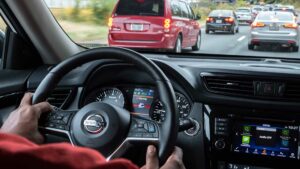
Senators calling on the FCC to approve “life saving” technology
By onTechnology
Some senators are calling on the Federal Communications Commission (FCC) to approve limited access to a “game changing safety technology” they say could prevent crashes and save lives.
The actual term for the technology is a mouthful. It is called “Cellular Vehicle-to-Everything (C-V2X) technology in the 5.9 GHz spectrum band.” It’s more commonly known as vehicle-to-vehicle (V2V) technology, a system that allows automobiles to communicate with each other, pedestrians, and nearby infrastructure.
In a joint letter, Sen. Gary Peters (D-Mich.) and Cynthia Lummis (R-Wyo.) urged the FCC to approve pending waiver requests so that C-V2X could be brought to market.
“C-V2X technology is poised to save lives, will pave the way for the future of automobile and transportation infrastructure, and is supported by public and private transportation stakeholders from local and state governments to industry, academia, and public safety groups,” the letter says. “C-V2X is an intelligent transportation system (ITS) technology that allows data sharing between vehicles, roadside infrastructure, and nearby road users to enable various safety and efficiency applications.”
It isn’t a new concept.
The Obama administration in December 2016 said making V2V connectivity standard, with cars being able to tell whether a traffic light is red and knowing to slow down, could save many lives.
One concept even sees the cars being aware of the cellphones in the population’s purses and pockets and preventing inattentive drivers from running into inattentive pedestrians.
“NHTSA estimates that safety applications enabled by V2V and V2I could eliminate or mitigate the severity of up to 80 percent of non-impaired crashes, including crashes at intersections or while changing lanes,” the National Highway Traffic Safety Administration wrote in a news release at the time.
Smart infrastructure, part of V2X connectivity, is being researched and developed in the U.S. and abroad for the safety of motorists and pedestrians. For example, Ford Europe and some of the OEM’s engineers in California have conducted trials of connected vehicle technology using geofencing, or a virtual geographical boundary, in Germany that “could one day do away with the need for speed limit signs completely,” according to a Ford news release.
The U.S. Department of Transportation (USDOT) said last September it will make $160 million in grants available annually over the next five years for smart infrastructure technology to improve the nation’s transportation infrastructure and make communities safer, including funding for vehicle automation and connectivity technologies.
Electronic Design contends that 6G capabilities would boost the safety efficacy of ADAS through increased radar sensing of the environment surrounding vehicles and objects in their paths and will be necessary to handle increased bandwidth use by autonomous vehicles (AVs).
“The aim is to improve driver awareness of obstacles and potential dangers, thereby reducing stress and accident rates,” Electronic Design states. “V2X also hastens traffic flow by giving an advanced warning (and mitigation options) of traffic congestion, intelligent speed assistance, and facilitating access to parking spaces.”
A long time coming
Advocates have been waiting years to see C-V2X in action. The FCC in November 2020 said it would begin offering waivers for review, prompting 18 requests to be submitted. However, none have been approved.
The FCC did not respond to a Repairer Driven News request for comment.
The senators said the time to act is now.
“Swift action on these waivers is essential given C-V2X technology’s potential to reverse rising roadway fatalities,” they said in their letter to FCC Chairwoman Jessica Rosenworcel.
The lawmakers said enabling C-V2X could also benefit the environment by preventing traffic jams and redirecting drivers to clear routes.
“C-V2X technology can improve roadway efficiency and contribute to emissions reductions,” the letter said. “In fact, the multi-agency U.S. National Blueprint for Transportation Decarbonization released in January 2023 stated that “connected mobility solutions enable unprecedented system-level improvements— better communication among vehicles and with infrastructure can smooth traffic flow and reduce congestion. These benefits cannot be realized without action from the FCC to allow the safe deployment and scaling of this technology.”
Joining the call
The Alliance for Automotive Innovation has joined the call to action. John Bozzella, its chief executive, said it has the potential to revolutionize automotive safety.
“It enables vehicles to see around corners, talk to other vehicles on the road, and to communicate with pedestrians, bicyclists, traffic lights and other infrastructure – instantly and in real-time,” he said. “This connected vehicle technology exists today, and major automakers are prepared to deploy it. Unfortunately, waiver petitions to bring V2X technology to U.S. roadways have languished at the FCC for more than a year.”
Jim Sayer, director of the University of Michigan Transportation Research Institute, said the situation is literally a matter of life and death.
He said: “Connected vehicle technology holds the promise to dramatically improve safety on our roads and highways. Every year that we wait to put the technology in place we’re losing thousands of lives that could otherwise be saved.”
Image
Featured image provided by IIHS
